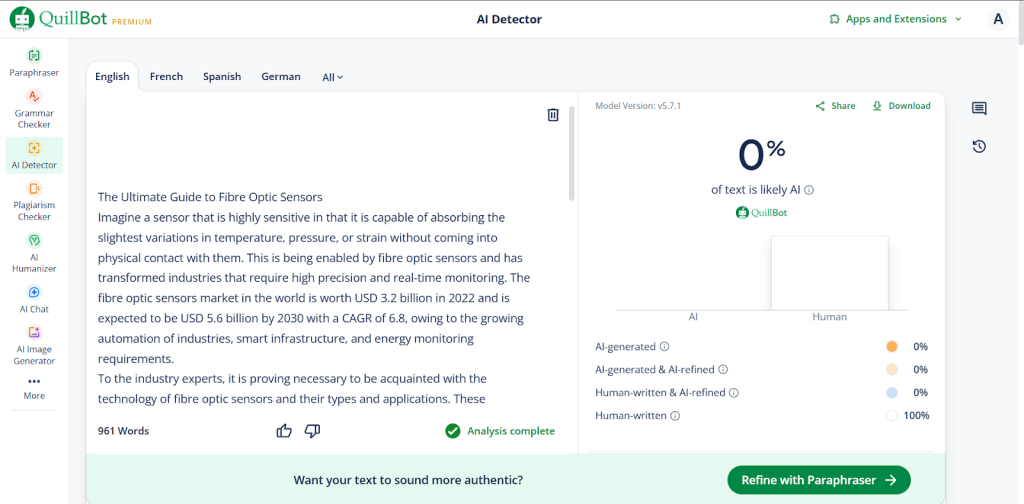The Ultimate Guide to Fibre Optic Sensors

Imagine a sensor that is highly sensitive in that it is capable of absorbing the slightest variations in temperature, pressure, or strain without coming into physical contact with them. This is being enabled by fibre optic sensors and has transformed industries that require high precision and real-time monitoring. The fibre optic sensors market in the world is worth USD 3.2 billion in 2022 and is expected to be USD 5.6 billion by 2030 with a CAGR of 6.8, owing to the growing automation of industries, smart infrastructure, and energy monitoring requirements.
To the industry experts, it is proving necessary to be acquainted with the technology of fibre optic sensors and their types and applications. These machines are the most accurate, minimise the risk of operation, and offer efficiency. This guide will examine the nature of fibre optic sensors and their benefits, as well as the importance of fibre optic sensors in the modern industry, and assist individuals in making informed decisions.
How Fibre Optic Sensors Work: Principles and Technology
Fibre optic sensors work by recording when there is a change in light signals that travel through optical fibres. The temperature, pressure, or strain changes cause such changes, so one can take accurate measurements without any physical contact using the sensors. The principle is based on the fact that it is possible to modulate the light properties in the fibre and then transform them into readable industrial monitoring data.
This is a non-contact sensing, which is accurate and safe, particularly in harsh or dangerous conditions. The capture of real-time data allows industries to analyse, in real time, the conditions around them to avoid failure of equipment. The fibre optic sensor is sensitive and stable; hence, it cannot be avoided in any application where high precision is required, as well as applications with a high response rate. Its flexibility means that it can be used in the manufacturing, energy, and structural monitoring industries.
Types of Fibre Optic Sensors and Their Industrial Applications
There are many types of fibre optic sensors depending on the needs of the industry. Here are the main types:
- Handheld Fibre Optic Sensors: Mobile devices to conduct brief checks in the manufacturing and maintenance process.
- Fixed-Mount Fibre Optic Sensors: These are mounted in the production lines and power plants to monitor continuously.
- Distributed Fibre Optic Sensors: Measure along long distances, as in pipelines or bridges.
- Drones with Fibre Optic Sensors on Board: Survey the locations that are difficult to access during energy and construction projects.
- Embedded Fibre Optic Sensors: These are built into the structures as a permanent way of measuring stress and temperature.
Advantages of Using Fibre Optic Sensors in Industry
Fibre optic sensors are a more efficient and safer instrument in industries.
- Early Fault Detection: This is used to identify anomalies leading to equipment failure.
- Very Accurate: Provide the right measurements even during severe or adverse conditions.
- Operational Safety: The workers do not face the risk since it is non-contact measurement.
- Energy Efficiency: Discover unproductive systems with the intention of saving energy and expenditure.
- Durability: It does not respond to electromagnetic interference and extreme environments.
Contradictions and Limitations of Fibre Optic Sensors
Although fibre optic sensors are very high efficiency sensors, they have the following challenges:
- Environmental Sensitivity: Dust, humidity, or high temperature can have an effect on the show.
- Bad connector installations: Connector installations may not be good and this may cause faulty readings.
- High Cost of installation and setup: It could cost more to install and establish compared to the traditional sensors.
- Maintenance complexity: The repairs and replacements are done with special knowledge.
Future and Trends in Fibre Optic Sensors
The future of the fibre optic sensors is determined by technology and industry requirements. Key trends include:
- Wireless fibre optic sensor: It is possible to conduct remote monitoring without complex cabling.
- IoT Implementation: Be connected to smart networks in factories via sensors to obtain real-time knowledge.
- High-Resolution Fibre Optic Sensors: Processes that require it can be found to even greater precision.
- Multi-parameter monitoring: It offers the opportunity to measure and monitor multiple parameters such as temperature, pressure, and strain on one device.
- Drone-Based Inspections: Enhance the surveillance of the inaccessible areas.
Choosing the Right Fibre Optic Sensor Partner
The fibre optic sensors are important to industries that require accuracy and safety in their activities, and, therefore, a reliable manufacturer should be selected. The sensors should be correct, stable, and of high quality in accordance with international standards.
Fibre optic sensors are certified, robust, and available to be integrated into the modern industrial systems in companies such as Tempsens. They are highly dependable and long-term players, as they are experienced in terms of research, customisation and international compliance. Having an established manufacturer as the added value would be a relief and would contribute towards the assurance that the fibre optic sensor solutions would ensure that operational efficiency would be maintained, downtime reduced, and provide accurate data in the long run.
Guaranteeing Fibre Optic Sensors Dependability
The choice of the right fibre optic sensors is important in those industries where accuracy and real-time information are crucial in order to maintain safety, efficiency and stability in the operations. Good sensors are employed to achieve the right measurements and dependability in problematic conditions in the long run.
When selecting fibre optic sensors, it is desirable to keep in mind those manufacturers with a high degree of experience, international certifications, and orientation to research and customisation. The inquiry to the industry players will normally push the companies like Tempsens due to its track record of delivering quality sensors that can be easily integrated into the industrial systems. Such leadership can ensure that the teams can make good decisions and survive in the long term.
Sources
Report


Basanti Brahmbhatt
Basanti Brahmbhatt is the founder of Shayaristan.net, a platform dedicated to fresh and heartfelt Hindi Shayari. With a passion for poetry and creativity, I curates soulful verses paired with beautiful images to inspire readers. Connect with me for the latest Shayari and poetic expressions.
